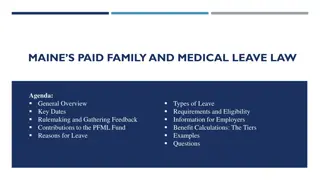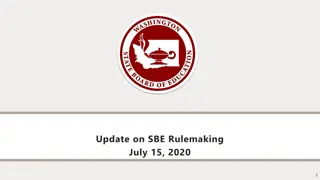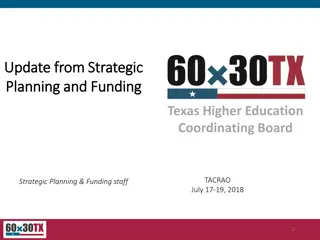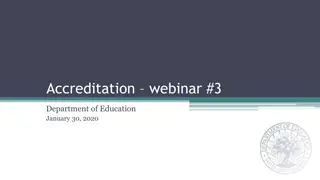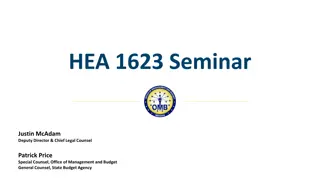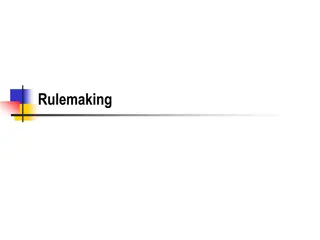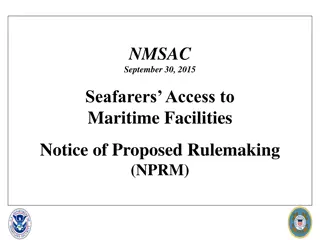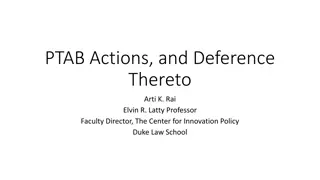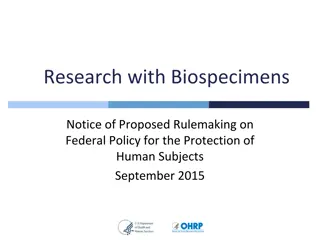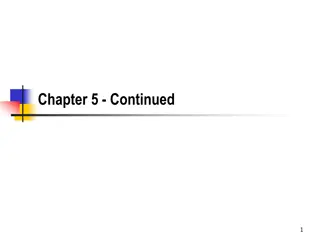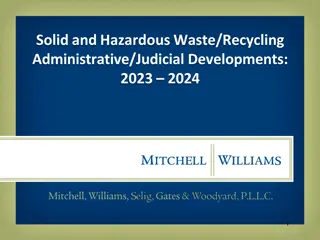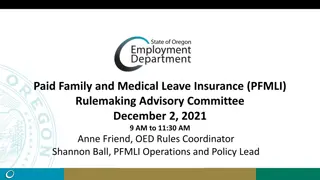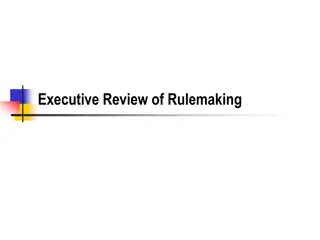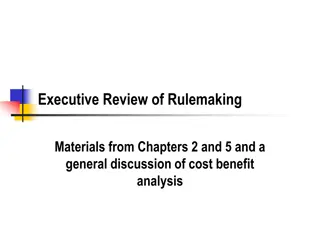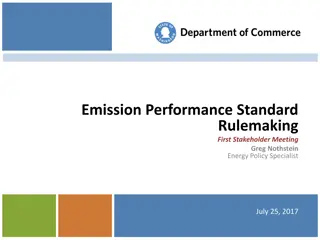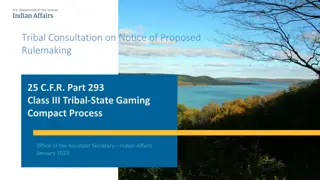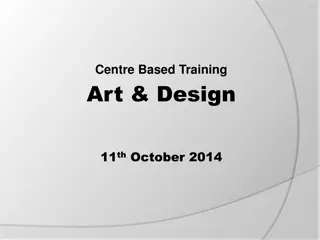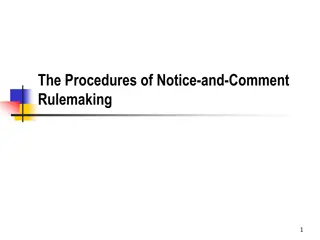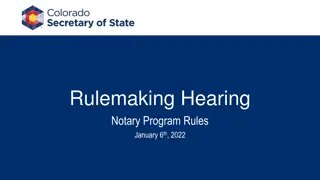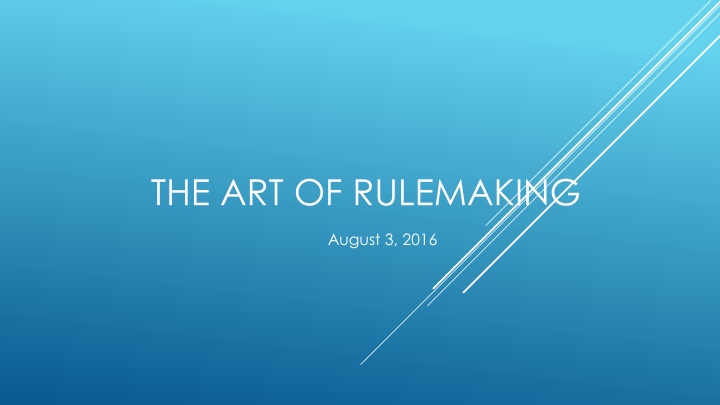
Federal Rulemaking Process: Key Components & Objectives
Explore the essential elements of the federal rulemaking process, including its necessity, triggers, regulation vs. guidance, and the importance of defining the problem. Learn why successful rulemakings are considered an art and the various steps involved in developing rules.
Download Presentation

Please find below an Image/Link to download the presentation.
The content on the website is provided AS IS for your information and personal use only. It may not be sold, licensed, or shared on other websites without obtaining consent from the author. If you encounter any issues during the download, it is possible that the publisher has removed the file from their server.
You are allowed to download the files provided on this website for personal or commercial use, subject to the condition that they are used lawfully. All files are the property of their respective owners.
The content on the website is provided AS IS for your information and personal use only. It may not be sold, licensed, or shared on other websites without obtaining consent from the author.
E N D
Presentation Transcript
THE ART OF RULEMAKING August 3, 2016
Objectives of Presentation Discuss why: 1. Rulemakings are necessary --Clarify differences between rulemaking and guidance 2. It takes so long to develop a rule 3. Successful rulemakings are all art 4. There s more to the actual rulemaking process Close with some final thoughts and observations 2
So whats the most important component of any rulemaking? 1. Defining the problem? 2. A diverse, experienced workgroup? 3. A vested workgroup? 4. Being organized identifying and sticking to milestones, etc.? 5. Support from your management? 6. Staying out of the public eye? 7. All of the above 8. None of the above Just being in the right place at the right time! 3
Part 1. Background and Case Study What is a Federal Rulemaking? The terms rule or regulation are often used interchangeably in discussions of the federal regulatory process. The Administrative Procedure Act (APA) of 1946 defines a rule as the whole or part of an agency statement of general or particular applicability and future effect designed to implement, interpret, or prescribe law or policy. The process by which federal agencies develop, amend, or repeal rules is called rulemaking. From: The Federal Rulemaking Process: An Overview, Maeve P. Carey, Congressional Research Service, June 17, 2013. 4
Why are rulemakings necessary? 1. Environmental problem exists that must be addressed 2. Experience with existing regulations identifies gaps, problems with implementation, etc. - Other voluntary solutions not workable 5
What triggers a rulemaking? Congress tells us - Statutory requirement - Congressional mandate The Courts tell us - We re sued and lose Respond to Petition by public or industry Agency initiative (top down/bottoms up) 6
Regulation vs. Guidance Regulation - Very formalized Must follow prescribed APA procedures - Considered a legislative rule - Has the force of law - Time consuming - Public review and comment - More rigorous and comprehensive(costs, benefits, risks, executive orders) Guidance - Does not have the force of law - Considered an interpretative rule - Supports implementation of rule or statute - Less time-consuming - Public review and comment not always necessary 7
What are the Five Major Stages of the Agency Development Process (ADP)? Stage 1. Tiering the Action and Obtaining Commencement Approval Stage 2. Developing the Proposed Rule or Draft Action Stage 3. Requesting OMB Review (if necessary) for Proposed (and Final) Actions Stage 4. Requesting Signature, Publishing an Action in the Federal Register, and Soliciting and Accepting Public Comment 8 Stage 5. Developing the Final Action and Ensuring Congressional Review
Why does it take so long to promulgate a rule? Because it just does! 1. Collecting information to define and understand the problem(s) 2. Workgroup process deliberations -- Developing issue papers, identifying options -- Resolving outstanding issues between workgroup members, reaching consensus 3. Factors to consider in issue papers/rule development costs, enforceability, legal defensibility, implementation, outcomes desired, stakeholder reaction 4. Development of background materials, draft preamble and regulatory text 5. Multiple workgroup and management review iterations 6. Agency review and OMB review cycles 7. Review comments from proposed rule 9 8. Final rule development: Repeat Steps 2 to 6 9. Prepare Response to Comments Document
A Case Study The Solvent Wipes Rule 10
Why a Rule Takes So Long A Case Study: The Solvent-Wipes Rule Time line (within reason) 1985 and 1987 1991 and 1994 1996 1996-1997 1997-1999 1999-2001 2000 We run out of money - Me and my tin cup! 2001 Agency Peer Review process begins Risk model -Do we or don t we? 2002-2003 Development of proposed rule; rule proposed 11/20/2003 2004 Rule makes front pages of Washington Post But for all the wrong reasons! 2004-2008 Risk modelling effort must be redone modelling obsolete 2006 Peer Review Process takes place 2006-2009 Model modified and NODA published with new risk modelling results 2009-2011 Review and modify risk model based on comments; resume workgroup process 2012 Rule delayed don t ask me why! 2013 Final rule issued 7/31/2013! Activity (Team of one for most part throughout process) Kimberly Clark and Scott Paper petition EPA to exempt disposable wipes from hazardous waste regulation no risk from land disposal Agency issues policy deferring issue to the Region and states Administrator initiates Common Sense Initiative (CSI) The fun begins! Office/Agency elect to develop rule Data gathering, outreach to stakeholders, risk model development Workgroup deliberations 12
Takeaways - A team of one is not a team! - Turnover can be a killer - Management support is critical - Estimating time to complete: What ever you estimate multiple by 2 or 3 - Know your own limitations - Realize you only control a small part of the process 13
Part 2: The Art of Rulemaking (or How does one go about writing a successful rule) Point 1: Create a World Class Workgroup/Team - Surround yourself with workgroup members smarter than yourself! -- Knowledge and experience with issues -- Can assist in rule development - Be proactive - Reach out and draft workgroup members interested in the rule - Create all for one and one for all attitude/buy-in 14
The Art of Rulemaking Point 2:Create and operate an efficient workgroup process -- Identify as many issues up front as you can to be addressed -- Develop Analytical Blueprint - Establish clear responsibilities for workgroup members - Get your Economic Analysis team on board as soon as possible -- Can identify problems with options for particular issues -- Can offer suggestions on other, better options - Get your lawyers and enforcement folks involved early -- Rule has to be legally defensible and enforceable - Develop roadmap 15
The Art of Rulemaking Point 2:Create and operate an efficient workgroup process (Continued) - Identify and monitor key deadlines and milestones (and stick to them as best you can) - Learn to say NO! - Really Listen to each other - Talk to stakeholders during proposal stage to better understand current system and problems - Consider use of workgroup retreat - Get Implementors involved early - Executive Orders can t forget 16
The Art of Rulemaking Point 3: Issues Both real and perceived issues - Identify and resolve key issues ahead of time (if you can) - Perception where you sit is where you are at! -- A big issue to one workgroup member may not be for lead office/others - Sometimes issues cannot be resolved at workgroup level -- Agree to disagree and escalate Point 4: Rule writing process - Clear and simple rule language -- Plain English always works! - Draft/review rule language together - Find copy editor if you can -- Use a style sheet -- Develop a system to avoid version control issues -- Use Share drive or Cloud-based drive 17
Activities You Cant forget Rule Implementation: Plan ahead - Communications materials/messages - Training and outreach - Webinars - Qs and As - Development of supporting guidances - Establish EPA/State Users Group 18
Some Final Thoughts 1. Externalities - OMB - Competing Agency and office priorities 2. The Keys To Success Create a Great Team and Find Consensus You can t go wrong! 19
Helpful Resources The Federal Rulemaking Process: An Overview https://www.fas.org/sgp/crs/misc/RL32240.pdf https://www.federalregister.gov/uploads/2011/01/the_rulemaking_process.pdf The Basics of the Regulatory Process https://www.epa.gov/laws-regulations/basics-regulatory-process EPA s Rulemaking Process https://www.agc.org/sites/default/files/Galleries/enviro_members_file/EPA%20R ulemaking%20Process%20Handout.pdf Significant Guidance Documents https://www.epa.gov/laws-regulations/significant-guidance-documents 20
So whats the most important component of any rulemaking? 1. Defining the problem? 2. Diverse, experienced workgroup? 3. Vested workgroup? 4. Being organized identifying and sticking to milestones, etc.? 5. Support from your management? 6. Staying out of the public eye? 7. All of the above 8. None of the above Just being in the right place at the right time! 21


